 | 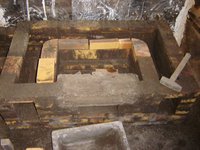 |
 |  |
 |  |
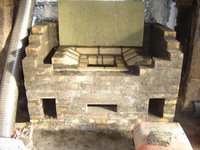 |  |
Wednesday, September 13, 2006
Psoriasis More Condition_symptoms
achieving
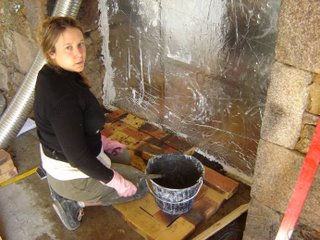 's go for the first layer which is a solid layer of bricks. Previously, we have arranged the bricks on the ground, I do not know if it was a good idea, it's true that it is not easy to be straight and steady ...
's go for the first layer which is a solid layer of bricks. Previously, we have arranged the bricks on the ground, I do not know if it was a good idea, it's true that it is not easy to be straight and steady ...
 2nd layer: it starts to have the techique! Must put a lot of mortar, brick and tap with hammer to create a suction effect that "glue" brick really well and spread the mortar underneath. Then, go over the outer seal to ensure water resistance.
2nd layer: it starts to have the techique! Must put a lot of mortar, brick and tap with hammer to create a suction effect that "glue" brick really well and spread the mortar underneath. Then, go over the outer seal to ensure water resistance.
planks on the sides are very useful to try to climb a wall right!
 3rd layer: this is it cuts commmencent! It forms the beginning of the flue which passes around the ash box. The flue will be by the left (non-ideal configuration relative to an exit from the rear, but that suits us not to too much beyond the stove in our fireplace).
3rd layer: this is it cuts commmencent! It forms the beginning of the flue which passes around the ash box. The flue will be by the left (non-ideal configuration relative to an exit from the rear, but that suits us not to too much beyond the stove in our fireplace). 
 's go for the first layer which is a solid layer of bricks. Previously, we have arranged the bricks on the ground, I do not know if it was a good idea, it's true that it is not easy to be straight and steady ...
's go for the first layer which is a solid layer of bricks. Previously, we have arranged the bricks on the ground, I do not know if it was a good idea, it's true that it is not easy to be straight and steady ...  2nd layer: it starts to have the techique! Must put a lot of mortar, brick and tap with hammer to create a suction effect that "glue" brick really well and spread the mortar underneath. Then, go over the outer seal to ensure water resistance.
2nd layer: it starts to have the techique! Must put a lot of mortar, brick and tap with hammer to create a suction effect that "glue" brick really well and spread the mortar underneath. Then, go over the outer seal to ensure water resistance. planks on the sides are very useful to try to climb a wall right!
 3rd layer: this is it cuts commmencent! It forms the beginning of the flue which passes around the ash box. The flue will be by the left (non-ideal configuration relative to an exit from the rear, but that suits us not to too much beyond the stove in our fireplace).
3rd layer: this is it cuts commmencent! It forms the beginning of the flue which passes around the ash box. The flue will be by the left (non-ideal configuration relative to an exit from the rear, but that suits us not to too much beyond the stove in our fireplace). Peter Grimm And Washington, Dc And Realtor
Overview before the start of construction:
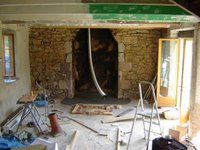 First and foremost, we removed the stones which formed the floor of the fireplace and were broken in order to run a mini-concrete slab armed ensure stability of the stove.
First and foremost, we removed the stones which formed the floor of the fireplace and were broken in order to run a mini-concrete slab armed ensure stability of the stove. Then we had our fireplace that tuberculosis is an old stone chimney wide (rectangular exit 60 * 120cm, height 10m) and not necessarily sealed the floors ...! For this operation, it took up to the roof and re-cement the whole chimney cap.
Preliminary tests:
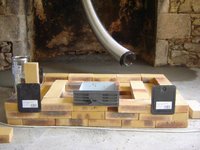 We have made these few preliminary tests that we have a little reassurance about the feasibility of things, and especially the ability to read and adapt the plan with respect to As Construction ...
We have made these few preliminary tests that we have a little reassurance about the feasibility of things, and especially the ability to read and adapt the plan with respect to As Construction ... insulation from the bottom of the chimney
 We isolated the bottom of the chimney with panels Firerock (wool + aluminum), both to protect the bottom heat (coated stones earth / straw) and allow for better heat recovery in the room.
We isolated the bottom of the chimney with panels Firerock (wool + aluminum), both to protect the bottom heat (coated stones earth / straw) and allow for better heat recovery in the room. molding elements:
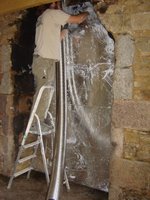 We also had various molding elements: lintel above the ashtray lintel above the fire door, the lintel above the flue outlet and plate to close the top of the post-combustion chamber. We built soaps wooden molds and then cast in refractory concrete. The refractory concrete has been achieved based Lafarge cement melted, vermiculite Vermex (replacing sand) and pozzolan (found easily in the garden to replace gravel).
We also had various molding elements: lintel above the ashtray lintel above the fire door, the lintel above the flue outlet and plate to close the top of the post-combustion chamber. We built soaps wooden molds and then cast in refractory concrete. The refractory concrete has been achieved based Lafarge cement melted, vermiculite Vermex (replacing sand) and pozzolan (found easily in the garden to replace gravel). Finally, we have to soak the bricks (A few minutes at least) before you start the refractory cement mortar (cement-based Lafarge melted and vermiculite Vermex).
Bmw Motorcycle For Sale In Missouri
Supplies and Preparations
Provide grinder, trowels, buckets, etc. ...
prévisonnel Budget is about € 1500 . 
| Designation | PU HT | Qty Price | Store | |
|---|---|---|---|---|
| Majolica, cheapest found, we will get the door, ash pan with vent and grille. | 1 | € 157 | Leroy Merlin | |
| Sweeping hatch 16 * 20cm cast | 2 | Brico-market | ||
| Brick leopard called "semi-refractory" 22 * 10.5 * 5.5cm | € 0.56 | 600 | € 401.856 | CQM |
| refractory brick 22 * 11 * 6cm € 0.92 | 300 | € 330.096 | CQM | |
| Diamond Disc Grinder | 1 | € 125 | Gedimat | |
| 25kg bags of cement melted | € 18.47 | 8? | Gedimat & CQM | |
| bag of vermiculite Vermex | Gedimat | |||
| Bag Pozzolana | 1 | Shop Green | ||
| rock wool panel + aluminum ep 100 * 60cm 3cm Firerock | 7 € 5.27 € 44.12044 | Leroy Merlin | ||
| Panel Rockwool 120 * 60cm 15mm ep Rocksol for expansion joint between the core and the refractory lining of the stove | € 3.76 € 22.4848 5 | Leroy Merlin | ||
| Subtotal | 1080.55724 € | |||
Provide grinder, trowels, buckets, etc. ...
prévisonnel Budget is about € 1500 .
Personalized Chapstick Wedding Favor
budget plans and adaptations ... The self and we
We started with a map of Finnish stove found on the internet, unfortunately expressed in inches and with sizes of bricks not found in France (26 * 13 * 7cm). after long hesitation on how to adapt this plan, we decided to make "best effort" priority in maintaining the dimensions of the flues. We found 22 bricks leopard * 10.5 * 5.5 cm and bricks of 22 * 11 * 6cm.
Cutaway profile:

Cutaway face:
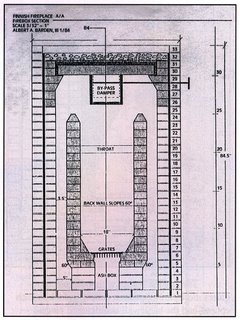
diagram of our stove:


We started with a map of Finnish stove found on the internet, unfortunately expressed in inches and with sizes of bricks not found in France (26 * 13 * 7cm). after long hesitation on how to adapt this plan, we decided to make "best effort" priority in maintaining the dimensions of the flues. We found 22 bricks leopard * 10.5 * 5.5 cm and bricks of 22 * 11 * 6cm.
Cutaway profile:

Cutaway face:

diagram of our stove:

Menopause More Condition_symptoms
... Or why we wanted to build ourselves a stove mass ...
Who are we?
We live in Brittany (Côtes d'Armor, Trégor) in an old stone village house, traditional in the region. We bought this house two years ago and since we are renovating ourselves in a respectful spirit of Man and Nature.
Why a masonry heater?
We studied a lot of heating solutions for our house. We had a preference for wood heating, renewable energy of choice. The mass stoves we have quickly convinced by their arguments Essential
- comfort :
- gentle heat : previously we had a wood stove "basic" steel, which heated to very high a few feet away, but leaving the bottom part at 10 °. The inertial mass of a stove should eliminate this problem.
- radiant heat and pleasant ,
- little convection : prone to allergies, we were sensitive to mites mixing and drying of the air that causes the convection heat a steel pan .
- inertia : it seemed very appropriate for a stone house that already has a strong inertia. In addition, the stone walls on the ground floor (where the stove is located), let in some air flow that can disrupt the convection not radiation,
- ecology : combustion is almost complete (90-95%), the exhaust fumes contain almost no particles and tar,
- economy : icing on the cake, one to two a day is soaring, and all types of wood are allowed (including conifers, unlike cast iron stoves e eg.). A simple palette is nicely,
- aesthetics : very debatable point, we find the mass stoves rather beautiful, and especially ours just embedded into the existing fireplace (yes, it's not laughing Brittany no chimneys of the time! dimensions: 1.65 m * 0.5 m * 2.5 m (width * high * prof). Approximate dimensions of the stove: 1.25 m * 0.8 m * 2.1 m (width * high * prof)).
Friday, September 8, 2006
Dream Mousse Blush Swatches
Introduction to mass stoves
3 types of heat
stoves mass, also called 'pans inertia', 'home ground', 'radiant', 'masonry heater', 'masonry stove', 'fireplace or stove to build', 'Kachelofen', etc. ... boistrès stoves are heavy (often more than one tonne) for burning wood at high temperature (often above 900 ° C). This allows a very good combustion energy released more and less as black smoke pollution are simply not burning gas at high temperature. An outbreak lasts one to two hours and the inertia of the pan captures this heat and distributes radiating all around for the rest of the day. More stove is heavy (inertial mass) the more he is able to store energy and therefore more time is needed before feeling the heat outside. But a heavy skillet radiates longer than a lightweight stove (up to 20 hours). One or two outbreaks (4 to 20 kg of wood) are enough for one day with a stove sized correctly.
There different types of mass stoves by region: Alsace ('Kachelofen'), Finland, Russia, Canada, Denmark, etc ... However, all these stoves meet the same principle of joint operation, which is to accumulate heat for it back then radiation.
system benefits

3 types of heat
- Convection: energy moves through a gas or liquid. What is known in general are rather radiators heaters that heat by hot air. Fast but problematic for the airways (moving dust, allergies ...). In addition, warm air rises to the ceiling or the floor and escapes easily through the ventilation slots and insulation,
- Conduction: energy moves through physical contact. A wood stove burns our fingers, a masonry heater warms and relaxes the back,
- Radiation: energy moves by infrared like the sun is healthy and comfortable. A stove sends the same mass as the sun rays.
stoves mass, also called 'pans inertia', 'home ground', 'radiant', 'masonry heater', 'masonry stove', 'fireplace or stove to build', 'Kachelofen', etc. ... boistrès stoves are heavy (often more than one tonne) for burning wood at high temperature (often above 900 ° C). This allows a very good combustion energy released more and less as black smoke pollution are simply not burning gas at high temperature. An outbreak lasts one to two hours and the inertia of the pan captures this heat and distributes radiating all around for the rest of the day. More stove is heavy (inertial mass) the more he is able to store energy and therefore more time is needed before feeling the heat outside. But a heavy skillet radiates longer than a lightweight stove (up to 20 hours). One or two outbreaks (4 to 20 kg of wood) are enough for one day with a stove sized correctly.
There different types of mass stoves by region: Alsace ('Kachelofen'), Finland, Russia, Canada, Denmark, etc ... However, all these stoves meet the same principle of joint operation, which is to accumulate heat for it back then radiation.
system benefits
- Comfortable about 80% of the heat emitted by radiation and only 20% by convection. This heat is healthy, smooth and homogeneous
- Effective: burning up 90-95% and a temperature of 1400 ° C heat up in the foyer (But leaving the stove only 100 to 150 ° C!) In the wood burning fireplace at high speed and very high temperature and in the upper (post-combustion chamber) the unburned gases mix with the secondary air and re-ignite,
- Ecological : a minimum of toxic gases exit through the chimney.
- The home oven can be used (ideal for breads, pizzas, etc. ...),
- The fumes can be directed through a heated bench,
- A exchanger Heat can be integrated to heat water and radiators and / or wall / floor heating.
Subscribe to:
Posts (Atom)